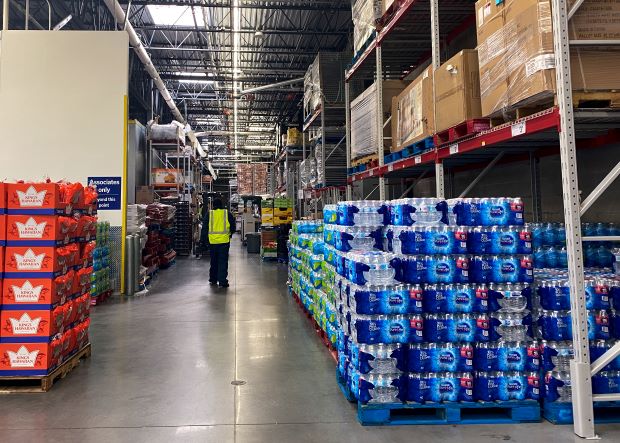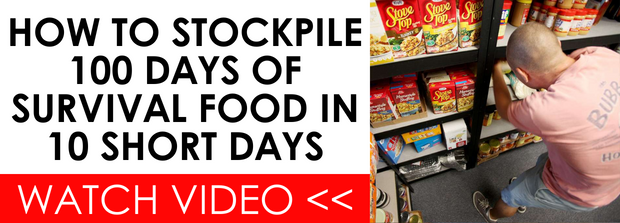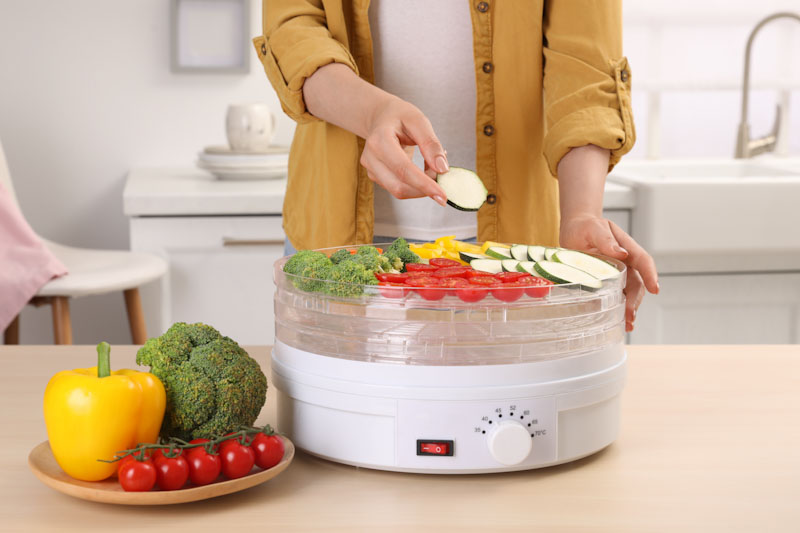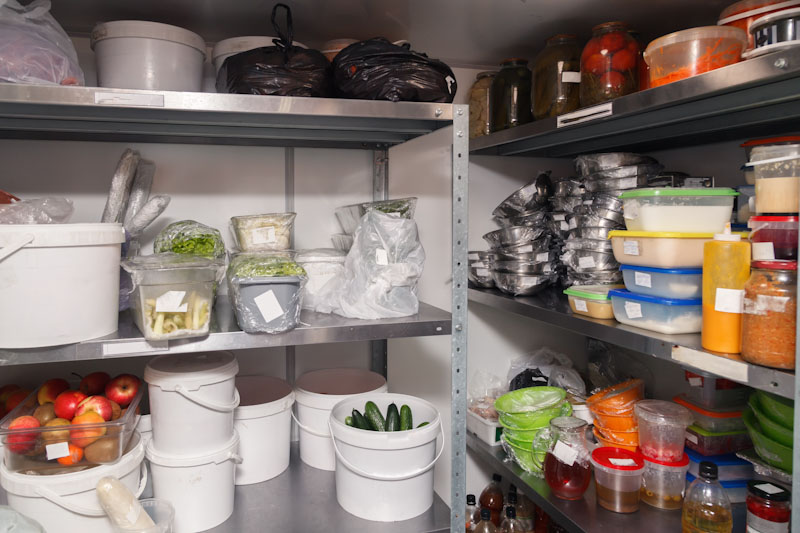Food and water are your main concerns during an SHTF event no matter how you look at it.
Your survival chances are also determined by the amount of food and water you managed to store. Storing these supplies is, in fact, one of the basics of emergency preparedness, and you need to take care of such tasks properly.
Establishing how much food and water one needs to store for proper survival is most times, a difficult task for most folks out there. However, this should be an easy-going process if you follow a few simple rules.
Any food and water storage begins with establishing how many people will be using those supplies during a crisis. If you have figured out the numbers, you are ready to begin with the next logical step. The one that requires you to estimate how much food and water you should store depending on the storage capacity you have available in your home.
FEMA recommends having a minimum of three day supply of food and water, but most Americans don’t have those resources in their homes. Sure, they might stretch their readily-available supplies if needed, but that doesn’t mean they will enjoy proper nutrition. Even those that have a week’s worth of supplies will not last long and will depend on others to continue the fight to survive another day.
Figuring out the caloric intake for your family
If you pay attention during your grocery shopping trip, you will notice that almost all commercially prepared food has a label indicating the serving size. Folks assume that such information is all it takes to build up a survival pantry. However, this is a wrong approach, and one will run out of food faster than expected if using this strategy.
If you want to do things properly, you should estimate the caloric intake needed for each of your family members rather than counting on the serving sizes.
Each person has a different caloric need based on their gender, age, and general activity. It is also worth mentioning that the weather is an important factor when you calculate the calorie intake of a human. If you live in a region that is prone to harsh winters and you are not a couch potato, you should probably double the calories you consume.
For hard manual labor such as digging, chopping wood, carrying heavy objects, or even walking for miles, some people will require 3,000 -4,000 calories easily.
Here are the general, recommended caloric needs:
Children between age 2 and 3
If the child is sedentary, the caloric intake should be between 1,000 and 1,200 calories. For moderately active and active children, the caloric intake should be between 1,000 and 1,400 calories.
Female
Age 4-8
Sedentary type: 1,200-1,400 Moderately active type: 1,400-1,600 Active type: 1,400-1,800
Age 9-13
Sedentary type: 1,400-1,600 Moderately active type: 1,600-2,000 Active type: 1,800-2,000
Age 14-18
Sedentary type: 1,800 Moderately active type: 2,000 Active type: 2,400
Age 19-30
Sedentary type: 1,800-2,000 Moderately active type: 2,000-2,200 Active type: 2,400
Age 31-50
Sedentary type: 1,800 Moderately active type: 2,000 Active type: 2,200
Age 51+
Sedentary type: 1,600 Moderately active type: 1,800 Active type: 2,000-2,200
Male
Age 4-8
Sedentary type: 1,200-1,400 Moderately active type: 1,400-1,600 Active type: 1,600-2,000
Age 9-13
Sedentary type: 1,600-2,000 Moderately active type: 1,800-2,000 Active type: 2,000-2,600
Age 14-18
Sedentary type: 2,000-2,400 Moderately active type: 2,400-2,800 Active type: 3,000
Age 19-30
Sedentary type: 2,400-2,600 Moderately active type: 2,600-2,800 Active type: 3,000
Age 31-50
Sedentary type: 2,200-2,400 Moderately active type: 2,400-2,600 Active type: 2,800-3,000
Age 51+
Sedentary type: 2,000-2,200 Moderately active type: 2,200-2,400 Active type: 2,400-2,800
Once you figured out how many calories you should consume per day based on your activity level, you have to prepare meals so that every member of your family gets his or her proper nutrition. To provide a balanced diet, you should make sure that all major nutrients are provided with each meal.
This may sound complicated, but you should start by keeping in mind that a human body needs five categories of ingredients: fat, protein, carbohydrates, fiber, and water.
Fiber and water are important for your health and well-being, and some may consider this as an independent addition. The human body cannot function properly without an adequate intake of protein, fat, and carbohydrates.
The recommended intake of protein, fat, and carbs:
Young children (of age between 1 – 3 years):
- Protein: 5 -20%, Fat: 30 – 40%, Carbs: 45-65%
Older children (of age between 4 – 18 years):
- Protein: 10 -30%, Fat: 25 – 35%, Carbs: 45-65%
Adults (19 years and older):
- Protein: 10 -35%, Fat: 20 – 35%, Carbs: 45-65%
These numbers are important to be remembered because an imbalanced diet will cause health problems and will trigger appetite fatigue faster.
A general rule of food storage states that one should only store foods his family eats, and common sense goes a long way here. Buy only the food your loved ones are accustomed to eating, the type of food you used daily. Never go for foods that you think and hope they will eat. An emergency situation is not a suitable experience to taste the culinary taste of your family.
Rather than picking everything you see on the grocery shelves, look at your favorite recipes and figure out a way to adapt or reinvent them with the items you store in your survival pantry.
If you want to settle on the ratios to provide a balanced diet, these figures should help:
Protein: 15% of your pantry supplies. Here you can have items such as meat, peanut butter, and assorted nuts.
Grains: 35% of your pantry supplies. Here you can have items such as cereals, pasta, rice, and even bread.
Vegetables: 20% of your pantry supplies. Here you can have items such as corn, carrots, peas, and other vegetables.
Dairy: 15% of your pantry supplies. Here you can have items such powdered milk and hard cheese.
Fruits: 15% of your pantry supplies. Here you can have all sorts of canned and dehydrated fruits.
Requirements for a one-year survival pantry
When starting with long-term food storage, many will get confused and get lost in the numbers. It is one of the most difficult things for new preppers to deal with.
Although most of them understand that their pantry needs to include basics such as beans, grains, fats, dairy items, baking ingredients, and various spices, figuring out the actual numbers is the real challenge. One important thing you need to remember is that a human adult needs a pound of dry food per day in order to survive.
Dry foods such as legumes, sugar, pasta, rice, and dehydrated vegetables or fruits are constantly on the grocery shopping lists of preppers. Here is what a one-year emergency pantry contained, which should be more than enough to feed a family of two:
- 25 pounds of flour
- 50 pounds of rice
- 25 pounds of pasta
- 120 pounds of whole-grain wheat
- 25 pounds of oats
- 15 pounds of millet
- 30 pounds of dried beans
- 5 pounds of lentils
- 5 pounds of split peas
- 25 pounds of cornmeal
- 10 pounds of soybeans
- 5 pounds of peanut butter
- ½ gallon of dehydrated eggs
- 10 pounds of textured vegetable protein (TVP)
- 4 pounds baking powder
- 4 pounds baking soda
- 40 pound of sugar
- 10 pounds of honey (I store a lot of honey as I use it for other purposes as well)
- 4 pounds molasses
- 4 pounds jam
- 40 quarts of vegetable oil
- 50 pounds dry milk
- 10 pounds salt
- 2 pounds yeast
- 3 gallons of vinegar
- 10 pounds dry soup mix
- A large variety of spices and seasonings
Storing water
When it comes to storing water, this is a much easier task compared to storing food. However, there are some things you have to remember when calculating how much water should be enough for your family’s needs.
To have proper hydration, you should drink half of your body weight in water ounces, in normal conditions. For example, if you weigh 160 pounds, half of that is 80, so that means you should drink at least 80 ounces of water each day. Most survival experts recommend keeping at least one gallon of water for each person per day. Said water should be used for both drinking and sanitation purposes.
I recommend going with one gallon and a half of water for each family member. This is how I’m doing it, and I’ve adjusted my water needs because heat waves may hit our area during the year.
One thing I have to stress when it comes to water storage is that every serious prepper should not concentrate their efforts on just storing water. You should learn how to find additional sources of water, both inside and outside your home, and also have the means to make that water drinkable.
Also, learning how to build a water generator is the best backup plan you can have for your water needs. I guarantee you will be way ahead of your neighbors during a water shortage.
Concluding:
The information provided in this article should help both new and experienced preppers figuring out how much food and water needs to be stored. I remember, I had a hard time when starting with all of this, and I hope you will figure out the right numbers for you much easier after reading this article.















Tim | March 19, 2020
|
While that is a great list of things to build up, the next piece is what to do with it all and how to prepare it. I realize that is outside the scope of this article, but people spend a lot of money to build preps and stores, but then when it all hits the fan, they don’t know what to do with what they have, don’t have recipes, don’t really know how or where to store things, and in the case of gear, have never taken it out of the box it came in to practice using it. Any chance of a follow-up article with some basic recipes on how to use the above the most efficiently to make it last the longest, but still get the caloric daily needs?
John Drake | March 22, 2020
|
Hey Tim,
Check out these 18th century cooking videos from Jon Townsends, he uses some of these items.
https://www.youtube.com/channel/UCxr2d4As312LulcajAkKJYw
ric | September 6, 2020
|
I agree and one thing I have done with my children is text food. We have a park with electricity and WIFI near us, as well as a small creek for fishing. We often spend all day there. For a test I made beans and rice with beef bullion in my electric pressure cooker to see how well it goes over.. Ages 9, 12 and 14 as well as myself all ate it. With Covid and food looking slim at times I explained why we are trying this so they know. I hope others are doing things like that as well.
Mimi Barre | March 19, 2020
|
Thank you for all the articles teaching me how to prep. I am Hunkering Down at home because I am 79, and the health gurus told us to. I am super healthy, but 2 weeks of isolation won’t hurt. I didn’t need to run to the store and strip the shelves. I have enough stashed at home. The only thing that I forgot was kitty litter, This is a good test of our sheltering in place abilities.
Bill In Idaho | September 6, 2020
|
Concerning Water . . . Separate your Requirements for Water: Safe to Drink (Potable) Water vs. Utility water. The amounts mentioned in the article appear to be for Potable Water ONLY ! I have 4 – 55 Gal. Drums of Utility water – for Flushing, Clothes washing, Drain Clearing, etc. – and even that won’t last long. My Potable water stores consist of 1.5 Gals. per person for 30 Days – Then What ? Keep it logical and sensible.
Jon Christiano | November 5, 2022
|
Hi Bill, Thank you for your comments. Many of us have a roof and gutters that collect and direct rain water to where we could use it, even if for nothing other than washing ourselves, clothes and flushing toilets!
Jon
JR | September 6, 2020
|
I like you guys thinking! I have been saying for years (unpopularly I might add. Teach your children to eat everything!) Sure you can store what they like but when that runs out, then what? They will be much better off if they are not fussy.. Fussy eating is the function of poor parenting. Kudos to this dad !who is making foods, explaining why and training his children., This is real parenting. Fussy eating is generally poor for the childrens health ,because it usually does not provide all nutrients and gives way too much processed and sugar foods. The way to proceed is adult leadership. Assume your children will eat good food and they will. No snacks in between meals unless the last meal was eaten reasonably well. No dessert unless meal eaten within reason. Do not make cleaning plate big issue give children small portions and give more as appetite allows and they want. Give dessert unless way too much left, or certain things not eaten at all. Don’t bring it up, follow the rules and it will all fall in place.Do allow for 1-2 things that each person just doesn’t like . This is normal But no more than that. Parents this requires you to eat the same way. Do not ever tell children you or the other parent don’t like something. Children will immediately think they don’t like it. Keep it to yourself. It took my kids 20 years to find out i don’t like squash except baked. I put small portion on plate and ate without comment..This also requires you to be an adult and cook. Does not have to be fancy to be good..Also snacks should only be healthful vegs and fruit and not all the time. Do this kids will eat it all! Good luck all! Jr
Anonymous | July 15, 2022
|
What about foods for vitamin C? What about dehydrated vegetables and dehydrated fruit? You could store canned fruit and vegetables but that gets bulky.
I figured out a meal plan involving 32 single ingredient #10 cans of dehydrated survival food ingredients to make a years worth of meals for myself and the 2 others in my prepping group. I bought when the cans were less than $20 each on sale with many between $7 and $10. I came up with recipes and tested them. That is just one level of our food storage. The two gentleman in my prepping group helped put the plan into action. I would like to get 4 of #10 cans of the Mountain House Freeze dried meat to round out the menu but that is out of our budget.
On another level, I have a linen closet filled with over another year of ingredients for shelf stable meals. That is another 1500 meals with 4 to 6 servings. The linen closet is a large one that is bigger than most kitchen pantries.
These lists are not one size fits all. Some have allergies. Other food items cost too much money. Some food items are not going to have a 25 year shelf life as some contain fats and will go rancid.
Then you get into how are you going to prepare those meals without things like water and electricity. Y’all need to have several backup plans.
Frank C | November 4, 2022
|
A good start to this is write down everything you consume in a notebook for a week. If you make a meal, lets say pasta night. How much pasta do you make? 1 box/pound and sauce? there’s 1 meal down. When you use meat, how much do you use for a meal? Now times that by 4 and you have a months worth of food you can use as a guide.
Don’t forget the small things like morning coffee or tea. Try using powdered creamer and see how you do with it. Freeze-dried coffee could be next to try.
Now this is just a guide to get started. Of course when the SHTF, your not going to be able to have dairy, produce, or much fresh meat, so you will need to find an alternative. Powdered milk or eggs. Many kids don’t care for powdered milk, so be aware.
ed | September 15, 2023
|
excellent